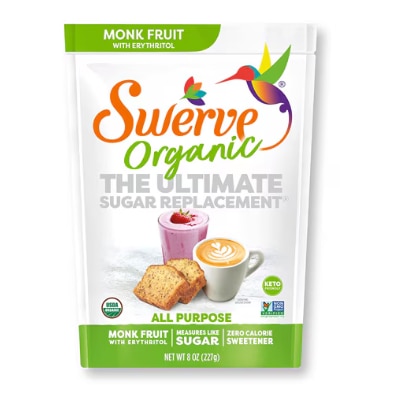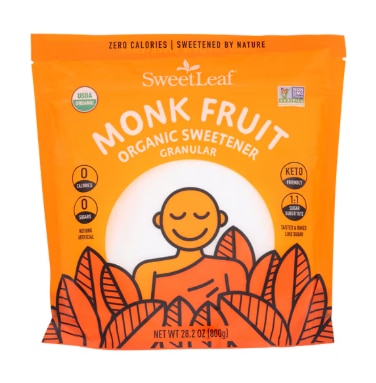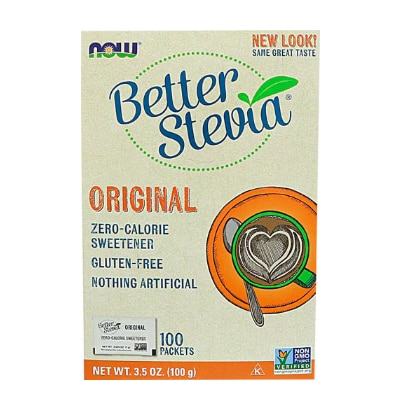Stroll into any coffee shop and the sheer array of sweeteners—from monk fruit extract to stevia and honey—demonstrates the country’s collective concern surrounding sugar.
For a good cause, too: Although the first instances of the link between increased sugar intake and medical issues dates back to 1907, the notion that sugar may be the culprit behind a heap of health complications didn’t take flight until the early aughts when the World Health Organization (WHO) declared the sweet stuff a “threat to the nutrient quality of diets.” Shortly thereafter, a handful of groundbreaking studies suggested that sugar is as addictive as cocaine—and just as challenging to break. It sent the world into a flurry (and not of the McFlurry kind).

Since then, sugar has been vilified across the board. Understandably so: An enormous body of research unequivocally shows that overindulging in sugar may contribute to the onset of type 2 diabetes and obesity. Excessive sugar consumption can also impair cardiovascular health, up your vulnerability to non-alcoholic fatty liver disease, irritable bowel syndrome and certain cancers, reduce brain volume and hasten cognitive decline, disrupt hormone harmony, send your blood pressure skyrocketing, expedite tooth decay, provoke acne flare-ups and even accelerate the rate at which your skin ages—and that’s not even close to an exhaustive list. Is it any wonder why we’re obsessed with finding satisfying substitutes?
And yet, comparing sugar to the likes of drugs, alcohol and nicotine is a powerful claim. Is it as addictive as these and other substances? And should it raise just as many red flags?
Let’s see what the science has to say about this ever-timely, controversial topic.
Is sugar a drug?
Maybe your best friend asserts that she’s “totally” addicted sugar. Or perhaps you’re finding yourself longing for a Dove bar or a Danish with an intensity that surprises you (and get downright grumpy until your sweet tooth has been sated). Possibly, your feeds are filled to the brim #sugaraddiction posts, a hashtag that has received millions of hits across social platforms.
Meanwhile, titles ranging from Why Diets Fail: Because You’re Addicted to Sugar to Salt Sugar Fat: How the Food Giants Hooked Us have flown off the bookshelves and directly into our psyches—and this is after author William Dufty insisted that sugar is a drug in his revolutionary tome, Sugar Blues, which maintained that sugar is “mortgaged energy” that robs our mineral and vitamin banks.
All of which begs the question: Is sugar actually a drug?
In a word: No.
While few (let’s hope) deem a stalk of sugar cane a square meal, sugar is first and foremost a food. To be more precise, it’s a soluble carbohydrate and macronutrient that plays a vital role in energy production and brain function. What’s more, glucose—a component of sugar that fuels your cells—can be a boon for postponing fatigue during long workouts by reloading glycogen stores. In other words, it’s a necessary and often unavoidable part of a diet, even if the type of sugar you ingest is paramount (a topic we’ll delve into below).
That said, sugar’s impact can be tremendous, so much so that you can feel like your life and happiness depends on it.
Then why does sugar get a bad rap?
As alluded to earlier, not all sugar is inherently harmful. Indeed, the very foods health practitioners and nutritional guides famously recommend contain, you guessed it, sugar. Cherries, carrots, beets, grapes, corn, apples, agave, bananas, oranges, peas, potatoes, pumpkin, milk—all of these often-praised eats boast modest amounts of natural sugar.
The problem is, sugar lurks in nearly every product imaginable. This includes those that seem like smart dietary choices, such as:
- Flavored yogurt
- Protein bars
- Granola
- Canned soup
- Dried fruit
- Fruit juice
- Marinara sauce
- Sorbet
- Condiments
- Trail mix
- Salad dressing
- Dairy-free milk alternatives
- Rice cakes
True, unless you have a food allergy or sensitivity, eating these foods in moderation isn’t likely to cause ill effects. The prevalence of sugar, however, combined with our natural, evolutionary inclination to seek out eats that not only taste fabulous but also give our brains and bodies a big boost of energy, can lead to revved-up cravings for more and more (and more) of it. Hence, sugar’s capacity to become what we immediately think of as “addictive.”
This concept exploded at the start of the 21st century when a slew of researchers began studying sugar’s mechanisms on the mind. A 2008 animal study performed at Princeton and published in Neuroscience and BioBehavioral Reviews indicated that under specific circumstances, rats may become “sugar-dependent,” complete with the hallmark signs of an addiction: Cravings, binging and withdrawal.
The British Journal of Sports Medicine featured research that built upon this and suggested that sugar can also induce tolerance, cross-sensitization, cross-tolerance, cross-dependence, rewards and opioid effects—so much so that the sweet stuff some us ladle onto our morning oatmeal was labeled by the researchers as “more rewarding than cocaine” and reveals“substantial parallels and overlaps” with drugs of abuse from the perspective of behavior and brain chemistry. And in 2013, researchers at Connecticut College illustrated that Oreos are as addictive as cocaine in lab rats, who, you guessed it, tended to eat the cream fillings first. Sugar’s reputation as a poison one should avoid at all costs naturally followed.
Your brain and body on sugar
Before we answer “is sugar actually addictive?,” let’s explore its effects on your brain and body in greater depth—and why it became notorious as an intoxicant.
History illustrates that our ancestors consumed roughly 20 teaspoons of sugar over the course of a year, or the equivalent of a large, premade fruit smoothie in our modern era. By contrast, now the average American eats 70 pounds of sugar every 12 months. Prior to the advent of Hershey’s kisses and energy drinks, we powered our cells by eating natural foods like berries and nuts, which our bodies broke (and continue to break!) down to generate its own glucose. And when we did come across something sweet, whether it was a pear or a fig, our brains said hallelujah. Our taste buds were delighted, our cognition swiftly sharpened and our capacity to physically move soared. Above all, perhaps, our moods radically improved, even if only for a short time. (Sugar crashes have and always will be a curse.)
Why?
To lay it out in clearer terms, research indicates that sugar fires up the reward system of the brain and prompts the release of dopamine—the same neurotransmitter that’s activated by alcohol, nicotine, sex and, yes, cocaine (as well as other drugsand behaviors).
Interestingly, and to be more precise, sugar causes dopamine to surge in the accumbens shell, a part of the brain that governs motivation, decision making, and what’s known as “hedonic processing” and “reward valuation,” or, simply put, our brain’s bias to gravitate towards things that make us feel good.
In other words, sugar provokes pleasure—even euphoria—and our brains, clever as they are, encourage (if not demand) us to pursue and maintain that high. Indeed, slightly older research illustrates that even the mere sight and smell of a sugary treat can ramp up the brain’s reward system and compel you to snag the last cookie in the house, no matter how many times you’ve vowed to shun all things sweet.
More recently, in 2025, researchers in Germany discovered that one of our neurons, the hypothalamic pro-opiomelanocortin (POMC), supersedes our intrinsic satiety signals and urges us to consume sugar, even when we’re full. Further, the study demonstrated that sugar ignites the brain’s opioid circuit, which plays a part in cognitive and impulse control.
To phrase it differently? One may then infer that repeated sugar consumption, like popping one M&M after another while watching a movie, can offset the balance between the prefrontal cortex and other neural segments, thus leading to overpowering sugar-seeking actions—and slowing our inhibitions the door.
To top it all off, sugar is wildly accessible, whether you get your fix at the vending machine in your office or succumb to your cravings seconds before checking out at the market (there’s a reason why those eye-catching displays are jam-packed with candy: They’re designed to facilitate impulsive purchases). More dessert? Oh yes.
But is sugar addictive?
In light of the research, to perhaps say nothing of our personal battles with trying to kick the sweet stuff, it would seem that sugar is in fact addictive. However, those less interested in incendiary headlines and more interested in the truth say otherwise.
Neuroscientists at the University of Alabama at Birmingham, for instance, state that there’s no direct correlation between high sugar consumption and mental health. Other scientists suggest that what studies have been done on sugar (in the context of it operating as an addictive drug) have not only been small in size but also conducted on animals. What’s more, a 2016 review of research argued that there’s scant evidence to prove sugar addiction in humans. Additionally, in 2025, Harvard claimed that while sugar can surely trigger cravings and compulsive eating, sugar is not a characterized as an addictive substance. Lastly, unlike, say, nicotine or alcohol, sugar isn’t something we can boot completely out of our diets, given that it appears in a host of natural foods.
While the stance on sugar as a narcotic may change—psychologist Ashley Gearheardt, for one, is intent on revising our definition of addiction—the bottom line is this: It’s unclear if sugar is actually addictive, but it can wreak havoc on mood, discipline, waistline, skin, and overall health. Which, really, is reason enough to exercise restraint when gazing at a display of glazed donuts.
How to scale back on sugar
Whether you’re convinced you’re addicted to sugar—and keep consuming it despite negative consequences—or you’ve merely noticed that your pants are a bit tighter and suspect those cinnamon rolls have something to do with it, do know that reducing your sugar intake isn’t as impossible as the world would have you think. Start with:
Play sugar detective
You might diligently strive to eat healthy but are unaware of how much sugar you’re truly consuming. Glance back at the list of sugar-filled foods included above and ponder what you can cut back on, naturally. A homemade vinaigrette composed of olive oil, balsamic and fresh herbs may turn out to be more tantalizing to your tastebuds than the sugar-heavy honey mustard you’ve been spooning over your daily salad.
Suss out dopamine-rich eats
Sugar isn’t the only food that boosts dopamine. Tyrosine, for example—an amino acid that abounds in nuts, cheese, eggs, chicken and fish—acts as a building block for dopamine production. You might also want to pile your plate with foods that contain phenylalanine, another essential amino acid that has a hand in dopamine synthesis. These include yogurt, milk, legumes (like chickpeas and black beans), and nut butters. Just be sure to go with a product with no added sugar, such as Barney Butter’s Smooth Almond Butter.
Swap out your sugary drinks
It’s all too easy to consume a surplus of sugar when you’re ingesting it through liquid calories. Beer, craft cocktails, sweetened iced tea, fruit juices, energy drinks, protein shakes—all typically overflow with incredible amounts of sugar. Exchanging a can of ginger ale for a glass of Spindrift can save you a bundle in your “sugar bank” (and leave room for desserts that actually count).
Discover bliss in real eats
We’re subjected to a near-constant barrage of images depicting everything from Dutch apple pie to straight-from-the-oven chocolate-chip cookies. And yet, whole, naturally sweetened foods can be just as delicious. Greek yogurt with blueberries, extra-dark chocolate or frozen dates filled with all-natural peanut butter and coconut flakes are downright scrumptious. Bonus: They also supply a terrific amount of minerals, fiber and antioxidants.
Practice the 15-minute rule
Your desire for a slice of Devil food cake may be so overwhelming that you’re having trouble concentrating, even if you know it’ll leave you with a sugar hangover in the morning. Yet research shows that sugar cravings generally last only 15 minutes. Distract yourself during that interval with a walk, a game of Solitaire, or by brewing a cup of tea. If the craving remains, tend to it, but mindfully. Which brings us to our next point…
Resisting stigmatizing sugar
There’s no doubt that eating excessive sugar can result in a cornucopia of issues. That said, viewing the sweet stuff as wholly verboten can backfire and lead to disordered eating. This can be especially true during the holiday season, when desserts are aplenty. A savvier tactic is to adopt intentionality. Sure, the word has been overused in recent years, but it’s a smart tactic when it comes to sugar. Downing two pumpkin spice lattes per day “because it’s in season” will add 100 grams of sugar to your daily intake and potentially contribute to the sugar-related complications referenced earlier. But genuinely relishing one or two throughout the holidays? That will simply make you feel all the merrier.
Featured Products



The post Is Sugar Addictive? Why It Feels Impossible to Cut Back on Sweets first appeared on The Upside by Vitacost.com.
